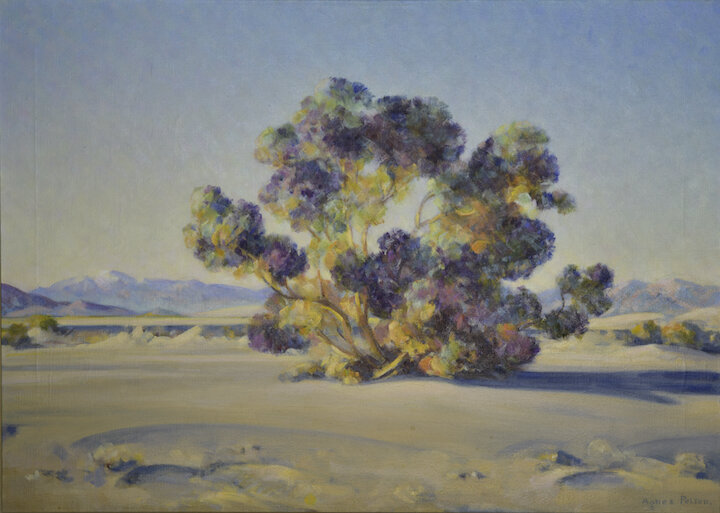Review: For Agnes Pelton, Color Reigns Supreme at Palm Springs Art Museum
Agnes Pelton, Departure, 1952. Oil on canvas. Collection of Mike Stoller and Corky Hale Stoller. Photo: Paul Salveson
Agnes Pelton was a cartographer of the unseen. Seeking to capture the “deeper resonance beneath the visible world,” Pelton painted landscapes of a different dimension. Her imagery came from within, often sourced from dreams, meditation and waking visions.
Her tracings of the invisible and their negotiation of abstraction and figuration, fantastical use of color, and strangeness proved alternative to the dominant trends of American modernism which, historically, have made her works hard to place within the history of art. While Pelton enjoyed early success in her career after studying at the Pratt Institute under Arthur Wesley Dow and exhibiting at the Armory Show of 1913, she was an artist that went on to pursue a spiritual mode of abstraction isolated from the mainstream art world. Perhaps this, in addition to the realities of being a woman artist during the early twentieth century, explains why her work remained in the shadows for so many years.
Agnes Pelton, Orbits, 1934. Oil on canvas. Collection of Oakland Museum of California, Gift of Concoursd’Antiques, the Art Guild of the Oakland Museum of California
Fortunately, Pelton’s mystical abstractions are finally getting their due in the first survey of her work in over 25 years. The traveling exhibition, Agnes Pelton: Desert Transcendentalist, organized by the Phoenix Art Museum, has settled in most appropriately at the Palm Springs Art Museum, just seven miles from Cathedral City, California, where the artist lived and created a great portion of her work.
The first time many of these abstract works have been exhibited in the area since their creation, this exhibition is a spectacular homecoming for the artist, made even more remarkable by the museum’s presentation of a concurrent exhibition of Pelton’s realistically-rendered desert landscapes completed by the artist at around the same time.
Believing “personal freedom is best embodied in inward reflection,” Pelton was deeply interested in the spiritual philosophies of Hinduism, Buddhism, and Transcendentalism, as espoused by Agni Yoga and Theosophy, new age movements that reached their height during the early 20th century.
Agnes Pelton, The Ray Serene, 1925. Oil on canvas.Collection of Lynda and Stewart Resnick. Photo: Jairo Ramirez
She created her first pure abstractions in the 1920s after moving to an old windmill in Long Island where she lived in relative isolation. It was her interest in Theosophy that first brought her to California in the early 1930s, where she spent a year studying at the Theosophical Society in Pasadena before deciding to take permanent residence in nearby Palm Springs.
Agnes Pelton, Future, 1941. Oil on canvas. Collection of Palm Springs Art Museum, 75th Anniversary gift of Gerald E. Buck in memory of Bente Buck, Best Friend and Life Companion.
In 1932 and at the age of 50, Pelton moved to the desert. She was enchanted by the environment there, painting desert landscapes which she sold to tourists passing through, as well as her more personal abstractions which she considered with more seriousness her life’s work.
The exhibition, Agnes Pelton: Desert Transcendentalist traces the development of Pelton’s more abstract work from her time in New York to eventual settling down in California. With the addition of the accompanying exhibition, Agnes Pelton Landscapes, organized by the Palm Springs Art Museum and curated by Christine Giles, curator of western and Native American art, the museum paints a more complete picture of the artist and in doing so, makes clear the profound influence that the desert landscape had on her and her work.
Agnes Pelton, Smoke Tree, ca. 1950, oil on canvas, 26 1/2 x 34 1/2 inches. Gift of Marjorie and Jim Treas, 15-2004
Agnes Pelton, Between Storms, Edom Hill, 1937, oil on canvas, 14 x 20 inches. Museum Purchase with funds provided by the General Acquisition Fund for Western Art, 2-1995
In fact, when viewing these exhibitions together, this skillful pairing of two very different halves of Pelton’s oeuvre enables us to see that both sets of works are indeed landscapes of sorts: one, landscapes of the natural world as we see it and another, landscapes of a nonmaterial world existing only within the mind’s eye.
Rochelle Steiner, the museum's chief curator and director of public programs and education, points out that there’s a lot to be gleaned about the artist by viewing these works together. She notes, “there was a sort of push and pull between the representation and abstraction, even though [the abstract works] have been thought of as devoid of figurative ground.” Steiner draws our attention to the commonalities between the two groups of work: the horizon line, coloration and palette, as well as a certain vibrancy of color that is carried throughout all of her works.
Agnes Pelton, Messengers, 1932. Oil on canvas. Collection of Phoenix Art Museum; Gift of The Melody S. Robidoux Foundation, 2014.39
Along with New Mexico modernist Raymond Johnson, in 1938 Pelton became a founding member of the Transcendental Painting Group, a group of artists that shared her vision in an abstract art that transcended the “reproduction of familiar objects and into the realm of a mental and spiritual awareness of the more individual elements of creative life.” For Pelton, turning inward was a necessity through which she was able to access something other worldly and translate it into a certain aesthetic of the imagination where color reigns supreme.
While much mystery surrounds Pelton’s life and art, one thing is for certain—the more we learn about her and see of her work, the more questions we are left with. Likewise, the exhibitions at the Palm Springs Art Museum are so good, they leave us wanting more. Thankfully, there’s a catalogue for that.
The exhibitions, Agnes Pelton: Desert Transcendentalist, and Agnes Pelton Landscapes are on view through September 6, 2021. Timed tickets are required for entry.






